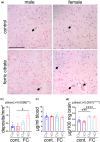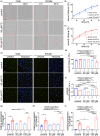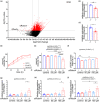Iron overload induces cerebral endothelial senescence in aged mice and in primary culture in a sex-dependent manner
- PMID: 37675802
- PMCID: PMC10652299
- DOI: 10.1111/acel.13977
Iron overload induces cerebral endothelial senescence in aged mice and in primary culture in a sex-dependent manner
Abstract
Iron imbalance in the brain negatively affects brain function. With aging, iron levels increase in the brain and contribute to brain damage and neurological disorders. Changes in the cerebral vasculature with aging may enhance iron entry into the brain parenchyma, leading to iron overload and its deleterious consequences. Endothelial senescence has emerged as an important contributor to age-related changes in the cerebral vasculature. Evidence indicates that iron overload may induce senescence in cultured cell lines. Importantly, cells derived from female human and mice generally show enhanced senescence-associated phenotype, compared with males. Thus, we hypothesize that cerebral endothelial cells (CEC) derived from aged female mice are more susceptible to iron-induced senescence, compared with CEC from aged males. We found that aged female mice, but not males, showed cognitive deficits when chronically treated with ferric citrate (FC), and their brains and the brain vasculature showed senescence-associated phenotype. We also found that primary culture of CEC derived from aged female mice, but not male-derived CEC, exhibited senescence-associated phenotype when treated with FC. We identified that the transmembrane receptor Robo4 was downregulated in the brain vasculature and in cultured primary CEC derived from aged female mice, compared with those from male mice. We discovered that Robo4 downregulation contributed to enhanced vulnerability to FC-induced senescence. Thus, our study identifies Robo4 downregulation as a driver of senescence induced by iron overload in primary culture of CEC and a potential risk factor of brain vasculature impairment and brain dysfunction.
Keywords: cellular senescence; cerebral endothelial cells; iron overload; molecular biology of aging; sex characteristics.
© 2023 The Authors. Aging Cell published by Anatomical Society and John Wiley & Sons Ltd.
Conflict of interest statement
All authors declare no competing financial interests.
Figures






Similar articles
-
G-quadruplexes Stabilization Upregulates CCN1 and Accelerates Aging in Cultured Cerebral Endothelial Cells.Front Aging. 2022 Jan 12;2:797562. doi: 10.3389/fragi.2021.797562. eCollection 2021. Front Aging. 2022. PMID: 35822045 Free PMC article.
-
Implicating endothelial cell senescence to dysfunction in the ageing and diseased brain.Basic Clin Pharmacol Toxicol. 2020 Aug;127(2):102-110. doi: 10.1111/bcpt.13403. Epub 2020 Mar 23. Basic Clin Pharmacol Toxicol. 2020. PMID: 32162446 Free PMC article. Review.
-
Nrf2 deficiency in aged mice exacerbates cellular senescence promoting cerebrovascular inflammation.Geroscience. 2018 Dec;40(5-6):513-521. doi: 10.1007/s11357-018-0047-6. Epub 2018 Nov 23. Geroscience. 2018. PMID: 30470983 Free PMC article.
-
MicroRNA-34a Induces Vascular Smooth Muscle Cells Senescence by SIRT1 Downregulation and Promotes the Expression of Age-Associated Pro-inflammatory Secretory Factors.J Gerontol A Biol Sci Med Sci. 2015 Nov;70(11):1304-11. doi: 10.1093/gerona/glu180. Epub 2014 Oct 28. J Gerontol A Biol Sci Med Sci. 2015. PMID: 25352462
-
Cellular and molecular biology of aging endothelial cells.J Mol Cell Cardiol. 2015 Dec;89(Pt B):122-35. doi: 10.1016/j.yjmcc.2015.01.021. Epub 2015 Feb 2. J Mol Cell Cardiol. 2015. PMID: 25655936 Free PMC article. Review.
Cited by
-
Microglial senescence in neurodegeneration: Insights, implications, and therapeutic opportunities.Neuroprotection. 2024 Sep;2(3):182-195. doi: 10.1002/nep3.56. Epub 2024 Sep 15. Neuroprotection. 2024. PMID: 39364217 Free PMC article.
-
Effects of Prebiotic Phytocompound Administration in Gestational Diabetic Dams and Its Influence on Offspring Cognitive Outcomes.Int J Mol Sci. 2025 Mar 28;26(7):3140. doi: 10.3390/ijms26073140. Int J Mol Sci. 2025. PMID: 40243881 Free PMC article.
-
Iron induces blood-brain barrier alteration contributing to cognitive impairment in β-thalassaemia mice.Sci Rep. 2025 Jan 2;15(1):533. doi: 10.1038/s41598-024-84395-z. Sci Rep. 2025. PMID: 39748061 Free PMC article.
-
Homeostasis and metabolism of iron and other metal ions in neurodegenerative diseases.Signal Transduct Target Ther. 2025 Feb 3;10(1):31. doi: 10.1038/s41392-024-02071-0. Signal Transduct Target Ther. 2025. PMID: 39894843 Free PMC article. Review.
-
HIF-1α Induced by Hypoxia Promotes Peripheral Nerve Injury Recovery Through Regulating Ferroptosis in DRG Neuron.Mol Neurobiol. 2024 Sep;61(9):6300-6311. doi: 10.1007/s12035-024-03964-5. Epub 2024 Jan 31. Mol Neurobiol. 2024. PMID: 38291291
References
-
- Algarin, C. , Karunakaran, K. D. , Reyes, S. , Morales, C. , Lozoff, B. , Peirano, P. , & Biswal, B. (2017). Differences on brain connectivity in adulthood are present in subjects with iron deficiency anemia in infancy. Frontiers in Aging Neuroscience, 9, 54. 10.3389/fnagi.2017.00054 - DOI - PMC - PubMed
-
- Block, G. A. , Fishbane, S. , Rodriguez, M. , Smits, G. , Shemesh, S. , Pergola, P. E. , Wolf, M. , & Chertow, G. M. (2015). A 12‐week, double‐blind, placebo‐controlled trial of ferric citrate for the treatment of iron deficiency anemia and reduction of serum phosphate in patients with CKD stages 3‐5. American Journal of Kidney Diseases, 65(5), 728–736. 10.1053/j.ajkd.2014.10.014 - DOI - PubMed
Publication types
MeSH terms
Substances
Grants and funding
LinkOut - more resources
Full Text Sources

